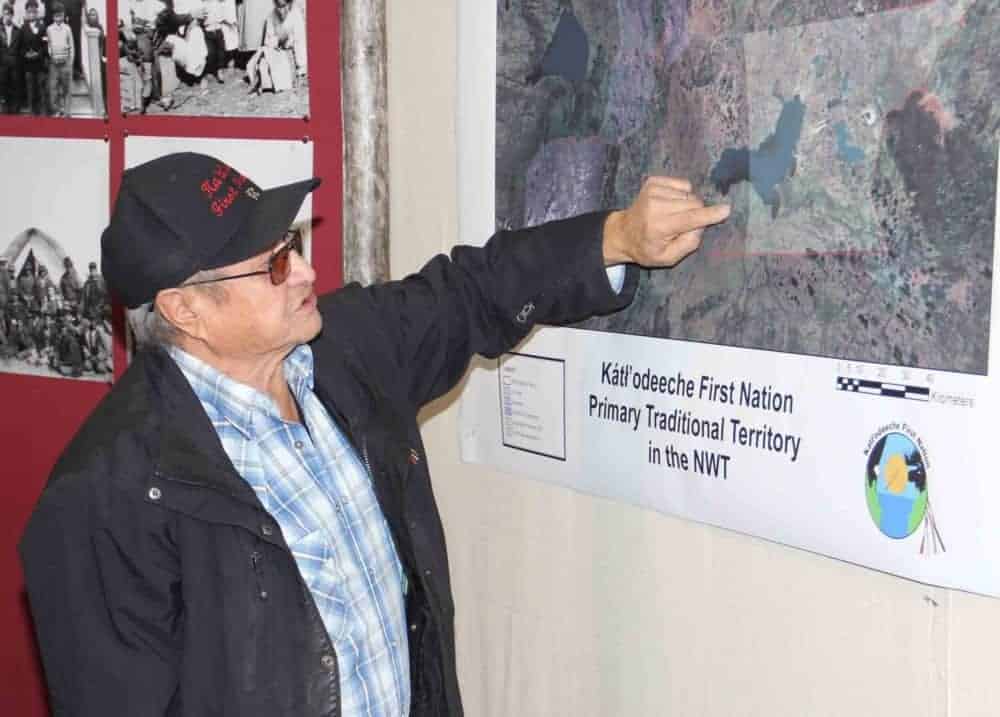The leaders of K'atlodeeche First Nation (KFN) have decided to stick to the important things, instead of being distracted by a controversial sign recently erected by the Northwest Territory Metis Nation.

Paul Bickford/NNSL photo
That was the main message from a Nov. 30 news conference by Chief April Martel and members of KFN band council.
The news conference was prompted by the Metis Nation's decision to erect a sign on Nov. 20 at the junction of Highway 5 and Highway 2 welcoming travellers to its 'traditional territory', a claim that is rejected by KFN.
The First Nation argued none of its traditional territory should be included in the Metis Nation claim and wants the boundary of the Metis claim to be the eastern edge of K'atlodeeche traditional territory. That is in the area of the junction of Highway 5 and Highway 6 towards Fort Resolution.
Martel noted that KFN recently asked the federal government to move the boundary of the Metis Nation claim east of K'atlodeeche traditional territory, which has been KFN's stated objective for about five years.
"We are awaiting for a response from Canada, which we expect to come in January," said the chief.
She added that, in the meantime, KFN elders and other members will continue to use their traditional territories as they have in the past.
"And we will honour our ancestors and their connection to the land, and we will ensure that our treaty rights are respected," she said.
Doug Lamalice, a band councillor and sub-chief of KFN, admitted the Metis Nation sign was annoying.
"And of course, it created some anger among our people. It created anger and frustration," he said. "So our elders, at the end of the day, pretty well spoke to us and told us that's not how we conduct ourselves."
Lamalice said the elders advised that KFN should keep its eyes on the real answer that's coming from the federal government.
"We really don't have an issue until that answer comes back from Canada," he said. "That sign, the elders told us, was just a weak stab (by the Metis Nation) at getting their point across in the territories and where they stand."
Lamalice said the elders helped him realize to stay humble, and remember the ways of the ancestors and how they conducted themselves on this land.
"So once we heard that, once I heard that, it brought me back to a certain place where I have to be," he said. "I can't be irate. I can't take matters into my own hands. I have to make sure we deal with it the way the elders have always taught us to deal with it, which is to wait for the proper answer, to come up with a proper solution."
Lamalice added the sign seemed to be a strategy on the part of the Metis Nation.
"And if we reacted in a wrong way, a negative way, it could be used against us later," he said. "So we have to be careful."
Lamalice said KFN must stand strong and proud.
"We can't stand in an angry way because that only creates conflict," he said. "We must stand in a way of our ancestors and to be strong and stand our ground. So we're waiting for Canada's word right now."
Roy Fabian, a former chief and now an advisor to KFN, said the issue is not with the Metis Nation.
"That sign is nothing," he said. "What we have an issue with is Canada (they need to) deal with that sign. Canada is the one that's allowing it to happen by negotiating on our traditional territory. So our issue is with Canada, not the Metis. They need to uphold our treaty and Aboriginal rights."
The Hub requested a comment from Garry Bailey, president of the Northwest Territory Metis Nation, on the KFN's stance on its boundary but there was no response by deadline.
During a gathering at the sign on Nov. 22, Bailey said it marked the beginning of Metis traditional territory that stretches to Fort Resolution and Fort Smith.
"We're not saying this is our territory only," he said at the time. "We know it's a shared territory. We're well aware of that and we have full respect for other First Nations."
KFN rejects the concept of shared territory with the Northwest Territory Metis Nation.